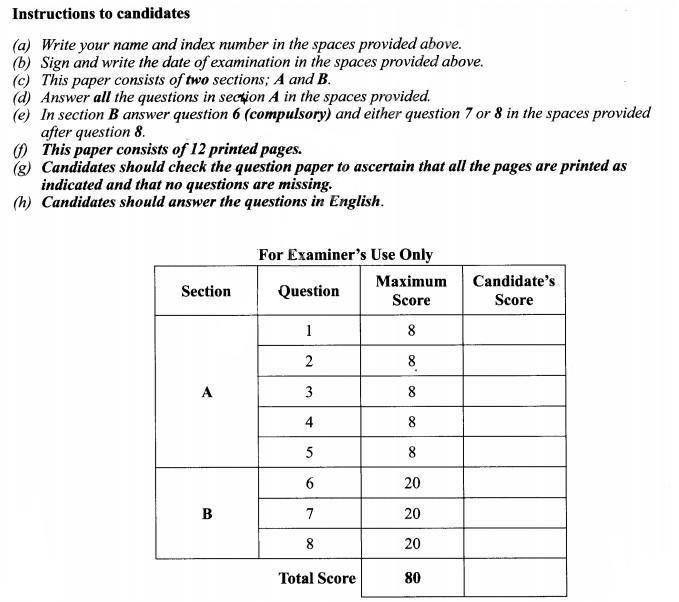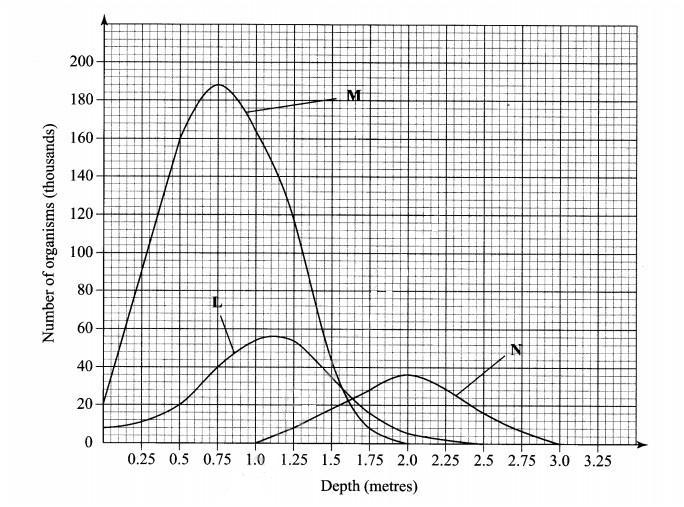2015 KCSE Biology Past Paper
Answer all the questions in the spaces provided.
1. (a) What is meant by the term binomial nomenclature? (1 mark)
………………………………
(b) State two guidelines that should be followed when typing scientific names.(2 marks)
…………………………….
2. During a lesson, students observed the structure of bat, cat and human forelimbs to determine their evolutionary relationship.
(a) State the name given to the structure of the limbs observed by the students(1 mark)
……………………………
(b) Name the type of evolution illustrated by the structure of the limbs observed.(1 mark)
…………………………………
(c) What evidence of evolution is illustrated by the limbs? (1 mark)
……………………………..
(d) State the significance of the type of evolution illustrated by the limbs. (l mark)
……………………………..
3. An individual is of blood group B positive.
(a) Name the antigens in the individuals blood. (2 marks)
………………………………
(b) Give the reason why the individual cannot receive blood from a blood group A donor.(2 marks)
…………………………..
4. Colour blindness is a sex linked trait controlled by a recessive gene b. If a mother is a carrier and the father is normal, What is the chance that their son will be colour blind? Show your working. (4 marks)
………………….
5. (a) State two advantages of using a coverslip when preparing a specimen for observation under a light microscope. (2 marks)
…………………….
(b) How is the low power objective lens manipulated to focus a specimen for observation under a light microscope? (2 marks)
…………………………..
6. Students set up an experiment as illustrated below.

(a) Name the physiological process that resulted in the observations made after 30 minutes.(1 mark)
……………………………
(b) State the importance of the physiological process investigated in plants. (1 mark)
…………………
(c) Explain the observations made after 30 minutes. (2 marks)
…………………………
7. How is a guard cell structurally adapted for gaseous exchange? (4 marks)
……………………
8. (a) Name the organism that: –
(i) causes malaria; (1 mark)
…………………….
(ii) transmits malaria. (1 mark)
……………………….
(b) State two control measures for malaria. (2 marks)
………………………
9. The diagram below shows an experimental set up to investigate a certain physiological process in plants.

(a) State the aim of the experiment. (1 mark)
………………………
(b) State the role of the following in the experiment:
(i) potassium hydroxide; (1 mark)
……………………….
(ii)Aluminium foil.(1 mark)
……………………..
(c) Account for the expected colour change in tube F.(2 marks)
……………………..
10. The diagram below illustrates skulls of human adult and chimpazee.

(a) State one difference the two skulls in the following structures:(3 marks)

(b) State the significance of the evolution observed on the parietal bone in the chimpanzee and human skulls. (1 mark)
…………………………
11. Name two structures used for gaseous exchange in plants. (2 marks)
……………………
12. (a) What is meant by each of the following:
(i) pyramid of biomass? ( l mark)
………………….
(ii) pyramid of numbers? (1 mark)
…………………….
(b) During an ecological visit to the Savanna Grassland, students were able to see lions, antelopes, vultures and pastoralists grazing their cattle. Construct a food chain with four consumer levels to illustrate the energy flow in the ecosystem. (2 marks)
……………………….
13. State three differences between the end products of mitosis and meiosis.(3 marks)
………………………………………………..
14. (a) Name two types of involuntary muscles in mammals. (2 marks)
………………………
(b) State the location of each of the muscles named in (a) above. (2 marks)
………………………………….
15. The photomicrographs below show the various stages of cell division in a certain plant.

(a) (i) Name the type of cell division illustrated. (1 mark)
…………………………………
(ii) Give a reason for your answer in (a) (i) above. (1 mark)
………………………………….
(b) (i) Name the stage of cell division labelled K. (1 mark)
……………………….
(ii) Give a reason for your answer in (b) (i) above. (1 mark)
…………………………..
16. State four structural differences between millipedes and centipedes. (4 marks)
………………………………………
17. (a) How is a human stomach adapted to
(i) protein digestion? (2 marks)
………………………..
(ii) churning? (2 marks)
………………………..
(b) What happens to the glucose synthesized during photosynthesis? (2 marks)
………………………
18. The diagram below shows an experimental set-up to investigate the conditions necessary for germination. Test tube P was placed in a refrigerator while Q was left at room temperature. The set-ups were observed regularly for two weeks but no germination occurred.

Explain the observations in P and Q.
P (2 marks)
…………………………..
Q (3 marks)
……………………………
19. (a) Using the axes provided below, sketch a curve to illustrate the growth pattern observed in the phylum arthropoda. (2 marks)

(b) Explain the growth pattern observed observed in arthropods. (3 marks)
………………………………….
20. Below are components of a simple reflex pathway:interneurone; muscle; motor neurone; sensory neurone; pain receptor; central nervous system.
List the components in their proper sequence during the transmission of a nerve impulse.(3 marks)
……………………………
BIOLOGY
Paper 2(Theory)

SECTION A (40 marks)
Answer all the questions in this section in the spaces provided.
1. The diagram below illustrates a blood capillary surrounding a structure for gaseous exchange in human beings.

(a) Name the gaseous exchange structure.(1 mark)
………………………..
(b) Identify the gases labelled Y and Z.
Y……………………………(1 mark)
Z…………………………….(1 mark)
(c) How does the gas labelled Y reach the inside of the blood capillary?(3 marks)
……………………………..
(d) How does cigarette smoking lead to lung cancer?(2 marks)
……………………………
2. The diagram below illustrates the structure of the female part of a flower.

(a) Name the part labelled W. (1 mark)
…………………………….
(b) Describe what happens when the pollen tube enters the structure labelled V. (5 marks)
………………………………………
(c) What do the structures labelled R and T develop into after fertilization?
R……………………………….(1 mark)
T……………………………….(1 mark)
3. (a) What is meant by the term genetics? (1 mark)
………………………….
(b) State two examples of discontinuous variation. (2 marks)
…………………………………
(c) A female with sickle cell trait marries a normal man. The allele for sickle cell is Hbs and the normal allele is HbA. Deternine the probability that their first born will have the sickle cell trait. Show your working. (5 marks)
……………………
4. In an experiment to investigate a factor affecting photosynthesis, a potted plant which had been kept in the dark overnight was treated as shown in the diagram below and exposed to light.

(a) Why was the potted plant kept in the dark overnight? (1 mark)
………………………..
(b) Which factor was being investigated in the experiment? (1 mark)
………………………
(c) (i) Which test did the students perform to confirm photosynthesis in the leaves labelled P and Q? (1 mark)
………………………..
(ii) State the results obtained in the leaves labelled P and Q.
P …………………… (1 mark)
Q……………………. (1 mark)
(iii) Explain the results obtained in the leaves labelled P and Q.
P …………………….(1 mark)
Q……………………..(l mark)
(d) What was the purpose of leaf Q in the experiment? (1 mark)
………………………
5. In an experiment to investigate a plant response, the set up shown in the diagram below was used.

(a) Name the type of response that was being investigated. (1 mark)
……………………
(b) If the Klinostat was not rotating:
(i) state the observations that would be made on the seedlings after three days; (2 marks)
…………………………..
(ii) explain the observations in (b) (i) above, (3 marks)
…………………………..
(c) If the experiment was repeated with the Klinostat rotating:
(i) state the observation that was made on the seedlings after three days; (1 mark)
……………………
(ii) give a reason for the observation made on the seedlings. (1 mark)
………………………
SECTlON B (40 marks)
Answer question 6 (compulsory) and either question 7 or 8 in the spaces provided after question 8. 6. The graph below shows the relative numbers of three main species of organisms in a pond.

(a) Giving a reason for your answer, which of the species is a
(i) producer?…………………………. (1 mark)
Reason …………………….. (1 mark)
(ii) secondary consumer………………… (1 mark)
Reason……………………….. (1 mark)
(b) State the depths at which each of the populations labelled L, M and N is at its optimum. L …………………………………… (1 mark)
M……………………………………. (l mark)
N……………………………………. (1 mark)
(c) (i) Which method may have been used to deternine the population of organisms labelled N in the pond? (1 mark)
……………………
(ii) Give a reason for your answer in (c) (i) above. (1 mark)
……………………
(iii) State the assumptions made when using the method in (c) (i) above. (4 marks)
…………………….
(d) State two reasons why primary productivity in the pond decreases with depth. (2 marks)
………………………
(e) Explain the ecological importance of fungi to plants. (2 marks)
……………………….
(f) Why is flooding likely to lead to a cholera outbreak? (3 marks)
………………………..
7. Explain the various ways in which seeds and fruits are adapted to dispersal. (20 marks)
……………………….
8. How is a mammalian heart structurally adapted to its function? (20 marks)
…………………………….
231/3
BIOLOGY
Paper 3 (PRACTICAL)

1 Using the pictures of animals provided below, complete the construction of the dichotomous key by filling the blank spaces. (13 marks)

1. (a) Animals with a backbone………………………………… go to 2
(b)Animals without a backbone……………………………….
2. (a) Animals with wings …………………………………….
(b) Animals Without wings…………………………………..
3. (a) Animals which live in water all the time………………….
(b) Animals which live in water some time…………………….
4. (a) Animals with scales ……………………………………
(b) Animals without scales ………………………………..
5. (a) Animals with legs ……………………………………
(b) Animals without legs …………………………go to 7
6. (a) Animals with six legs ………………………. butterfly
(b) Animals with eight legs ……………………………….
7. (a) Animals with a shell …………………………….. Snail
(b) Animals without a shell ……………………………
8. (a) Animals with a jelly-like body …………… ..
(b) Animals without a jelly-like body ……………………..
9. (a) Animals with a segmented body …………………………
(b) Animals without a segmented body …………………. Octopus
2.Below are pictures of three mammalian vertebrae

(a)Identify the type of vertebra labelled
F …………………….. (1 mark)
G …………………….. (l mark)
H …………………….. (1 mark)
(b) Label five parts of the vertebra labelled H. (5 marks)
………………….
(c) Name the articular facets labelled K and L.
K …………………….. (l mark)
L ……………………. (1 mark)
(d) How does each of the parts of a vertebra enable a mammalian skeleton to carry out its functions? (4 marks)
…………………..
3. You are provided with a 250 ml beaker, four test tubes, solutions labelled D and E, iodine and Benedict’s solutions.
Half fill the beaker with the hot water provided to create a hot water bath.
(I) Label the four test tubes as follows:
(i) test tube 1, D+Iodine
(ii) test tube 2, D+E+lodine
(iii) test tube 3, D+Be|ledict’s solution
(iv) test tube 4, D+E+Benedict’s solufion
(ll) Put 1 cm3 of solution D in each of the four test tubes.
(III) To the D+Iodine test tube, add one drop of iodine solution and shake to mix.
(IV) To the D+E+Iodine test tube, add lcm3 of solution E and two drops of iodine solution. Shake to mix.
(V) To the D+Benedict’s solution test tube, add 1 cm3 of Benedict’s solution and shake to mix.
(VI) To the D+E+Benedict’s solution test tube, add 1cm3 of solution E and l cm3 of Benedict’s solution. Shake to mix.
(VII) Observe the changes in each of the four test tubes.
(VIII) Put all the four test tubes in the hot water bath and observe carefully for about five minutes.
(a) Record the observations and conclusion for each of the four test tubes in the table below.(8 marks)

………………….
(b) What was the role of each of the following in the experiment?
(i) solution E (1 mark)
………………………
(ii) hot water bath. (1 mark)
………………………..
(c) Give the identity of E in human beings. (1 mark)
…………………………
(d) Explain the observations made on the reagents tested with Benedict’s solution. (2 marks)
……………………….

